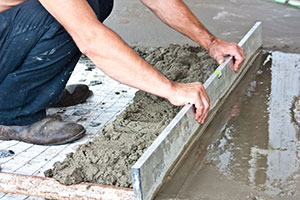Common Concrete Project Mistakes (and how to avoid them)
January 27th, 2015
 Concrete pouring is often considered to be one of the most dangerous and concerning aspects of the construction industry. Because time is often limited during construction projects, it puts a stress factor onto the completion of concrete work, which really needs a suitable amount of time taken to be completed successfully. Workers are often rushed to complete concreting work due to the often demanding time frames given by clients, and this can sometimes lead companies to take short-cuts on safety procedures.
Concrete pouring is often considered to be one of the most dangerous and concerning aspects of the construction industry. Because time is often limited during construction projects, it puts a stress factor onto the completion of concrete work, which really needs a suitable amount of time taken to be completed successfully. Workers are often rushed to complete concreting work due to the often demanding time frames given by clients, and this can sometimes lead companies to take short-cuts on safety procedures.
Unsafe concrete pouring can cause incidents that can be deadly to workers. Therefore, it is very important to pour concrete properly and ensure safe work procedures remain in place. If concrete work is conducted poorly, you may find some of these issues arising.
- Understaffed – On a work site or in a residential situation, it is important that there are enough helpers and workers to carry out the work. Not having enough people to help with the job will usually cause accidents and costly mistakes that could have been avoided. Lack of helpers may also lead to the concrete to harden before the levelling and smoothing is complete, making it unworkable.
- Reinforcement issues – Concrete is a strong material on it’s own, but can sometimes lack tensile strength. In order to reinforce concrete so it can last for many years, it often needs glass, plastic, or metal fibers mixed with it. As the concrete hardens around the fibers, it creates an even stronger bond. Sometimes this step can be skipped to save time, effort and money, however it does not allow the concrete to last as long.
- Not enough curing time – Concrete generally only takes between 24 and 48 hours to set, however it can take around a week to properly cure. This process is especially important if you are going to be painting the concrete, walking on it, or placing furniture on it. For best results, laying a tarp onto the concrete is ideal. Not allowing enough curing time due to time restraints does not allow the finished product to last as long as it would if it had been allowed to cure for as long as possible.
- Too much water – There is a certain amount of science to mixing concrete properly. Many people want to add more water to make the spreading and pouring process quicker, and it’s tempting to add more water after it has been laid to give it a “smooth finish”. However, it is unnecessary, and adding too much water only makes the concrete weaker.
- Improper planning – It’s important to plan ahead of your concreting task and ensure you have everything you need to make the project run smoothly. Foremost, making sure the site for the concrete is well prepared is of high importance. The correct sized gravel should be used under your concreted section, and you will need to ensure that it’s not too thin or small. Choosing the wrong gravel can create settling or bunching after the concrete has been poured.
- Choosing the wrong mix – If you place an order for concrete, it’s essential that you communicate to your supplier what kind of application you are wanting the concrete for, so that you can get the best mix for your project. If you are unsure of what mix to order, ask for recommendations when you place your order.
- Improper finishing – Finishing the project in the right way will give you a great end result, and many people get this part wrong. The job is not completed when you have prepared your site and the concrete arrives. For best results, do not overwork your concrete or use the trowel excessively. Doing this can make your mix dry, unworkable and lead to cracks. If you have never worked with concrete before, then consider hiring an expert to come in and ensure these last steps go smoothly.
Concrete can be difficult to work with, but if you have the right knowledge, people and tools, you’ll find that you will have yourself a lot easier of a job on your hands. Ensuring that you have planned your project efficiently will ensure there are less hassles and – hopefully – no safety incidents.
 Concrete pouring is often considered to be one of the most dangerous and concerning aspects of the construction industry. Because time is often limited during construction projects, it puts a stress factor onto the completion of concrete work, which really needs a suitable amount of time taken to be completed successfully. Workers are often rushed to complete concreting work due to the often demanding time frames given by clients, and this can sometimes lead companies to take short-cuts on safety procedures.
Concrete pouring is often considered to be one of the most dangerous and concerning aspects of the construction industry. Because time is often limited during construction projects, it puts a stress factor onto the completion of concrete work, which really needs a suitable amount of time taken to be completed successfully. Workers are often rushed to complete concreting work due to the often demanding time frames given by clients, and this can sometimes lead companies to take short-cuts on safety procedures.